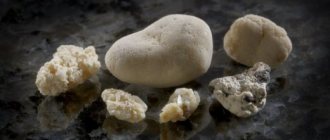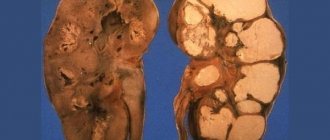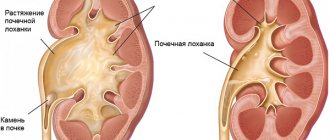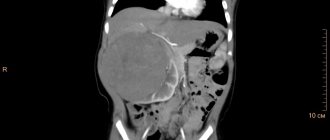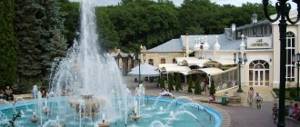Any inflammation associated with urological medicine brings not only discomfort to a person, but also disrupts the normal functioning of other organs. Untimely consultation and treatment of pathologies can lead to a chronic form of kidney inflammation or its loss. High results in the treatment of kidney diseases can be achieved by combining drug treatment with sanatorium treatment. Specialized sanatorium institutions with a urological focus carry out a number of measures aimed at eliminating inflammation and preventing relapses. In this article we will talk about kidney treatment in a sanatorium.
What is chronic pyelonephritis
Normally, the renal pelvis is sterile; urine collected in the renal pelvis is also sterile. The appearance of microorganisms here causes an inflammatory response of the body, and then pyelonephritis (an inflammatory kidney disease of a bacterial nature) may occur. The course of this disease occurs in three variants:
- Acute process;
- Chronic process (it can be the result of an acute one);
- Chronic process with exacerbation.
In chronic pyelonephritis, exacerbation develops when the number of bacteria in the pelvis increases significantly, remission occurs when the number of microbes decreases. It is very important to continue treating new pyelonephritis until the pathogen is completely eliminated, so that there is no risk of chronic inflammation.
Pyelonephritis does not have a specific pathogen; inflammation can be caused by completely different microbes, but the most typical pathogen is Escherichia coli, which lives in the human intestine. Therefore, hygiene is of great importance to prevent the occurrence of disease.
Chronic pyelonephritis can develop from the acute stage if it has not been completely cured, or it can proceed in a latent form for a long time, turning into a chronic process. If you do not pay due attention to the treatment of chronic pyelonephritis, over time the healthy tissue of the affected kidneys will be replaced by connective tissue that does not perform any functions. As a result, the kidneys will not, for example, filter blood normally. This will lead to the development of renal failure, which significantly worsens the prognosis of the disease.
The complex treatment of chronic pyelonephritis necessarily includes sanatorium-resort treatment, which is carried out in regions with a mild and warm climate, where it is possible to take mineral waters, both in the form of baths and internally. Treatment must be carried out during the remission stage of the disease.
In pregnant women
Pyelonephritis in pregnant women is dangerous due to the development of late toxicosis, which can lead to premature birth.
Since women cannot use most medications during this period, treatment is carried out according to the following scheme:
| Treatment method | Description |
| Positional therapy | A woman should take the knee-elbow position for 10-15 minutes 4 to 7-10 times a day. |
| Drinking regime | If there is no swelling, then you can drink up to 2-3 liters every day. It’s better if it’s compotes, jelly, water. |
| Phytotherapy | Particularly useful is a decoction of oats, which does not increase the tone of the uterus, but relieves inflammation. |
| Drug therapy |
|
Forms of chronic pyelonephritis
The disease can have two forms:
- A latent form of the disease can develop after acute pyelonephritis. It is characterized by an almost complete absence of symptoms, with the exception of a slight increase in temperature. But, as a rule, there are inflammatory changes in the urine.
- The recurrent form is more common - it occurs in 80% of patients with pyelonephritis. With this form of the disease, relatively well-being alternates with periods of weakness, a slight increase in temperature, and pronounced changes in urine tests. With untimely and inadequate treatment, this disease leads to the gradual development of asthenia, hypertension, and then renal failure.
Urological sanatoriums in Russia
Below are the names of some sanatoriums specializing in urology and the treatment of urolithiasis of the kidneys.
Sanatorium “Mineral Waters”, Zheleznovodsk
Located in a picturesque park area near the lake. In the lobby of the residential building there is a pump room that supplies Novoterskaya healing water. This is a carbonated medicinal table mineral water with a pleasant taste.
Specialized in the treatment of metabolism, gynecological diseases, sexual dysfunction, diseases of the genitourinary system and digestive organs. In addition to basic water and mud therapy, it provides services in herbal and physiotherapy, psycho- and hirudotherapy.
The sanatorium offers guests comfortable rooms, dietary meals and additional services for active recreation, self-care and a pleasant pastime.
Sanatorium “Rodnik”, Anapa
Located on the Black Sea coast. There are three balneological springs on the territory:
- low-mineralized medicinal water “Spring”,
- highly mineralized, hydrogen sulfide-sulfide water of the Matsesta type,
- highly mineralized iodine-bromine chloride-sodium water, reminiscent of the composition of Dead Sea water.
Provides treatment for gynecological, urological, urolithiasis and urinary tract diseases, neurology, dermatology, problems of the cardiovascular system and musculoskeletal system.
The range of services includes mud therapy, radon baths, manual and visceral therapy, acupuncture, physiotherapy, halo- and hirudotherapy. The highlight of the establishment is gravitational rehabilitation. A wide range of procedures will provide successful spa treatment of urolithiasis.
Sanatorium “Belokurikha”, Belokurikha
Settled in the foothills of Altai. It is one of the oldest and largest health complexes in this region. It is considered a leader among resorts specializing in the treatment of the urinary and reproductive systems. For the procedures, low-mineralized nitrogen-silicon thermal water “Belokurikha Vostochnaya” and healing mud are used.
The sanatorium treats urological, neurological, dermatological and gynecological diseases, diseases of the gastrointestinal tract and cardiovascular system, eyes and respiratory organs. In addition to the basic range of services offered, the list includes aromatherapy, health path, speleotherapy and paraffin-ozokerite treatment.
Sanatorium “Podmoskovye UDP”, Domodedovo district, Moscow region
Located on the banks of the Rozhaika River, surrounded by forest. Offers its visitors restoration and treatment programs. Among other things, the list of services includes climatotherapy, diet and cryotherapy, and electrolight therapy.
The main profile is diseases of urological, gynecological, nervous and digestive, endocrine and cardiovascular systems. Mineral and hydrogen sulfide waters and healing mud are used for procedures.
Sanatorium “Poltava – Crimea”, Saki
Located on the Black Sea coast. For treatment, highly mineralized silt sulfide mud and brine of Lake Saki and mineral water (analogue of Essentuki-4) are used. Here you can cure inflammatory diseases of the genitourinary system, urological and gynecological diseases, infertility and sexual disorders, diseases of the gastrointestinal tract, peripheral nervous system, diseases of the musculoskeletal system, respiratory and ENT organs.
Urological Center of Branch No. 1 of the Federal State Institution “Main Military Clinical Hospital named after. Academician N.N. Burdenko" provides patients with highly qualified diagnostic and treatment assistance for cystic kidney lesions. The center is equipped with a modern computed tomograph. CT with contrast clarifies the exact localization of renal cysts, determines the possible nature of the contents of the cyst cavity and pathological changes in its wall, as well as the relationship with the renal collecting system.
Kidney cysts
– benign thin-walled formations of round or oval shape. They develop from the renal parenchyma and usually contain serous fluid. Typically, patients are diagnosed with single cysts, the size of which varies within 3 cm, but can reach up to 10 cm.
Symptoms of chronic pyelonephritis
Unlike the acute stage, which is accompanied by a rise in temperature to high numbers, chills, nausea and severe weakness, the chronic form of the disease does not always have pronounced symptoms.
Low temperature, fatigue, discomfort in the lumbar region, not associated with movements, can form a picture of chronic pyelonephritis. Most often, this disease is bilateral and is characterized by diffuse, dull pain in the lower back. An increase in temperature is not always observed, but changes in urine tests are always detected.
It should be remembered that a simple urine test, collected using simple rules, can reliably indicate the existence of a problem such as pyelonephritis.
What are the symptoms of urolithiasis?
Very often, the formation of stones in the renal system can only be detected by chance during routine examinations. Sometimes a specialist suspects urolithiasis when a patient comes in with complaints of general malaise and certain problems with urination.
The most common symptoms indicating urolithiasis are the following:
- frequent urge with pain and high discomfort;
- the appearance of hematuria in the secreted fluid, as well as turbidity in the urine;
- pain in the lumbar region, intensifying with changes in body position or even slight physical activity. When kidney stones move, the pain radiates to the lower abdomen, groin or genitals. The most acute pain occurs with renal colic, when pain in the lumbar region does not stop for a couple of days. The appearance of such more requires urgent therapeutic measures;
- unreasonably high blood pressure;
- body temperature that does not decrease above acceptable levels, which indicates the development of pyelonephritis against the background of urolithiasis.
More on the topic: How are strips designed to determine acetone in urine?
Prevention of chronic pyelonephritis
To prevent the development of this disease, first of all, it is necessary to cure acute pyelonephritis, which in most cases is the main cause of chronic inflammatory processes in the kidneys. You should never self-medicate; treatment should be carried out under the supervision of a doctor, in a hospital or at home, depending on the severity of the manifestations of pyelonephritis. It is extremely important to achieve complete removal of the pathogen from the urinary system. And after that, you can consolidate the achieved success with a course of sanatorium-resort treatment. Procedures in sanatoriums will improve the flow of urine, restore all kidney functions, eliminate residual inflammatory processes, and also prevent the development of new exacerbations.
In order to reduce the risk of pyelonephritis, it is necessary to strictly follow the rules of hygiene and not ignore any inflammatory processes in the body, even if they do not bother you too much. It is also advisable to take vitamins to strengthen the immune system and avoid hypothermia.
An important role for the prevention and treatment of pyelonephritis is played by adherence to the diet and drinking regimen prescribed by the doctor. As a rule, during an acute process, it is recommended to increase the amount of fluid you drink per day; The consumption of fried, spicy, salty foods, baked goods and fresh white bread is prohibited. It is also practiced to avoid foods that can cause allergies due to weakened immunity. In case of exacerbation of chronic pyelonephritis, it is recommended to reduce the amount of salt consumed per day, it is necessary to exclude dishes with strong meat broths, spicy foods and spices.
Typical procedures for spa treatment of urolithiasis
When referred to a sanatorium, urolithiasis is treated comprehensively. The sanatoriums carry out a number of procedures that serve to prevent diseases and reduce the risk of relapse. Some of them can speed up the rehabilitation period, as well as destroy small formations in the genitourinary system.
More on the topic: How is a rapid urine test performed?
As a rule, procedures include mud applications, baths and showers (if balneotherapy is indicated), physiotherapy and diet therapy, as well as mineral waters, which are included in the patient’s drinking regimen. If necessary, your doctor may prescribe certain medications.
Hydro procedures
Restoring renal function after removal of stones in some cases can take a long time and require complex procedures in boarding houses. But the patient’s return to an active and long life will be a worthy reward.
Treatment of chronic pyelonephritis
One of the most effective components of successful treatment of chronic pyelonephritis is sanatorium-resort treatment, which allows you to use the most modern methods of eliminating inflammation, cleansing the kidneys and normalizing the human condition. Only thanks to complex treatment, including recovery in sanatoriums, are patients able to quickly return to a normal rhythm of life.
But it should be remembered that there are a number of restrictions for taking courses of sanatorium treatment for patients with kidney diseases. In cases of chronic renal failure above stage 2, high blood pressure, and severe anemia, procedures are not performed in such institutions. Also, patients with acute pyelonephritis or diseases requiring surgical intervention should not visit sanatoriums. In order for the effect of sanatorium treatment to be maximum, the disease must be in remission, confirmed by tests. Also, with pyelonephritis of a single kidney, the patient should not have problems with the outflow of urine and the presence of inflammation, otherwise sanatorium-resort treatment cannot be carried out without complications.
Treatment of the chronic form of pyelonephritis is a long process that lasts for years, but it will allow you to preserve kidney function, and therefore an active life and ability to work.
The main factor in sanatorium-resort treatment, thanks to which it is possible to improve the patient’s condition, is the presence of mineral waters. They are part of many procedures aimed at treating pyelonephritis. With the help of health baths and ingestion of mineral water, inflammatory processes in a person are reduced and harmful substances are eliminated from the kidneys.
Treatment procedures carried out in sanatoriums as prescribed by a doctor for patients with chronic pyelonephritis:
- diet therapy;
- mud applications;
- drinking treatment with mineral waters;
- balneotherapy (baths, showers);
- physiotherapy (heat therapy).
Currently, you can get high-quality sanatorium-resort treatment for this disease in hospitals and balneological centers, which are offered in regions such as KavMinVody and Belarus.
Greater Yalta: health resorts
Gurzuf
Ai-Danil Krasnodar region: health resorts
Sochi
Rus', Odyssey, Sochi, Boarding house Vesna, Oktyabrsky, OK Dagomys, Golden Ear, Progress, KSKK Aqualoo, White nights, Polar region, OK Sputnik, SKO Adlerkurt building Coral, named after Frunze, Boarding house Burgas Big Alushta: health resorts
Alushta
Slavutich Krasnodar region: health resorts
Sochi
Stavropol region, North Kazakhstan region Adlerkurort building Neptune
Anapa
Boarding house Ural, Nadezhda, Rodnik, Anapa-Okean, Parus, Ryabinushka, DiLuch, Rossiyanka
Gelendzhik
Blue Wave, Red Talka, Rus, Friendship, LOK Horizon
Tuapse
Belaya Rus Western Crimea: health resorts
Evpatoria
Dream, Pobeda, Primorye, SKK Family Resort
Sandy
Chernomorets
Saki
Sacropolis, Northern Lights, named after Pirogov, Saki, Poltava-Crimea, Yurmino Belarus: health resorts
Minsk Region
Pines, Priozerny, Belorusochka, Rassvet
Vitebsk region
Borovoe, Forest Lakes, Children's sanatorium Rosinka
The Grodno region
Ozerny, Radon
Gomel region
Pridneprovsky, Golden Sands, Gomel branch of the Belarusian Railways
Mogilev region
named after Lenin KavMinVody: health resorts
Kislovodsk
Plaza, Zarya, Villa Arnest, Solnechny, Tsentrosoyuz, Jinal, Krugozor, Narzan Valley, Rodnik, Moscow, Narzan, named after Kirov, Picket
Essentuki
Istok, Kazakhstan, Narzanov Valley, Metallurg, Pearl of the Caucasus, named after Sechenov, Victoria, Shakhtar, Central Union of the Russian Federation, named after Pavlov, named after Andzhievsky, Nadezhda, Healing Key
Pyatigorsk
Gallery Palace, Pyatigorsk Central Military Sanatorium, Rodnik, named after Kirov, Dawns of Stavropol, Mashuk, Tarkhany, named after Lermontov, Lesnaya Polyana, Lenin Rocks
Diet
The daily calorie content of the menu for patients with chronic pyelonephritis is 2000-2500 kcal. The diet should be complete in terms of protein, carbohydrates, fats and vitamins. Product Lists:
| Group of products and dishes | Products and dishes |
| Allowed |
|
| Prohibited |
|
Articles on the topic
- Complications of pyelonephritis in men and women - clinical picture, treatment methods
- Causes of pyelonephritis in women - types and manifestations of the disease, diagnosis, therapy
- Treatment of pyelonephritis at home - medication regimen and folk recipes


